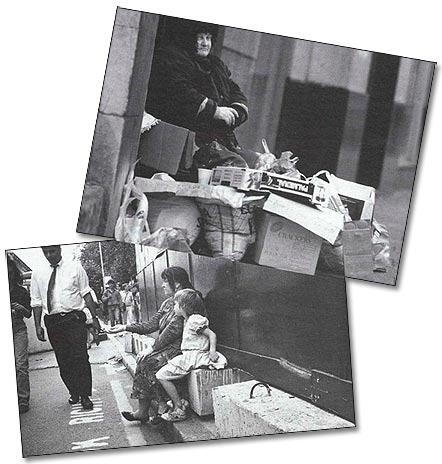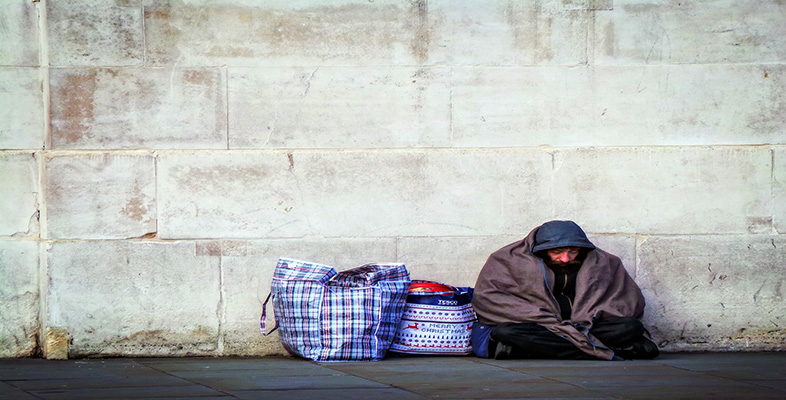1.2 From private trouble to public issue: the emergence of negative equity
In the housing market, owner-occupiers have occasionally sold their property at a price below that which they paid for it. In the early 1990s, large numbers of property owners in the UK (and particularly in south-east England) found that the market value of their houses and flats had fallen below the original purchase price. A private trouble emerged as a public issue. It was named, and became the problem of ‘negative equity’. This was identified as a widespread problem rather than a matter of individual misfortune: it was seen to have causes (in the state of the economy) which lay beyond the reach of the individual. It was also identified as something that required a public response – from mortgage lenders and the government.
Can this shift of a private trouble to a public issue be understood as a consequence of the numbers of people involved?
The numbers involved provide only part of the explanation why this trouble became a public issue. Other ‘troubles’ involving equally large numbers of people attracted less attention and concern. For example, the continuing rise in rents for tenants of council housing and housing associations, which took place at the same time, was largely viewed as a fact of life. Furthermore, despite the attempts of housing professionals to place the issue on the public agenda, the decaying state of Britain's owner-occupied housing stock (built before 1945) continued to be defined as a personal problem facing those who happened to be living in older houses. They were expected to resolve it through their own investment in renewal and repair, rather than through any collective effort. We might suggest that a number of other features of negative equity helped it become a public issue:
-
Who was involved? The social and political standing of those experiencing this trouble affected its visibility. Home owners were seen as innocent victims of a situation beyond their control. They were the symbolic representation of government policies designed to create a ‘property-owning democracy’. Negative equity was thus a politically sensitive matter.
-
What was its claim on public attention? Negative equity was seen as connected to matters of public policy – first, the drive to extend home ownership and, second, the contemporary management of the national economy which was associated with an initial boom and then a slump in housing prices.
-
What sort of problem was it? Negative equity was seen as having significant social and economic consequences. It was associated with mounting personal debt, a lack of social mobility, and a fear of the future that prevented people taking risks. In particular, it was seen as causing a problem of consumer confidence: this reduced patterns of consumer spending, which in turn further threatened the prospects of economic growth. It was therefore also a political problem for the government, as it provoked extensive public discussion about the presence or absence of a ‘feel-good factor’, particularly among the government's erstwhile supporters.
What this brief example suggests is that the scale of a ‘trouble’ is not by itself a sufficient condition for understanding why the trouble becomes a public issue. We need to understand the social context in which it occurs – its links to other current issues and values. The case of negative equity also suggests that we need to think about who is involved and how they are perceived, in terms of their social standing and significance. In very simple terms, we might suggest that there are two routes to troubles becoming public issues which are distinguished by the question: whose problem is this?
Some troubles become social or public problems as a result of the actions of those people who experience them (or those who speak on behalf of such people). Thus, campaigns aim to capture public attention and direct it to the conditions or experiences that specific groups of people are suffering. Negative equity would be one example of this route. Other examples include campaigns to draw attention to the widespread incidence of domestic violence, despite its relative public invisibility; to raise concern about the abuse or maltreatment of vulnerable people in institutional care; or to reveal the scale of, and suffering associated with, homelessness. Such campaigns try to articulate the experience of a particular condition and demand public action to remedy it. This route is built around the argument that people have problems.
The second route is different, in that it is built around the argument that some people are problems. There are some types of people who are seen as a problem for others or for society at large (even if these people do not define themselves in the same way). For example, we might be able to identify groups of people who are seen to pose a threat or danger to society in some way: vandals, noisy neighbours, hooligans, prostitutes, the mentally ill, and so on. The demand here is that society does something about ‘these people’ – police them, lock them up, treat them, and so forth.
Sometimes, of course, the same problem might be identified through both these routes. If we examine homelessness as a social problem, it is possible to see its being defined as a problem that some people have and as a problem that some people are. In the first case, the problem is perceived as the lack of access to a basic human need – adequate accommodation – which results in homeless people experiencing deprivation, misery and suffering. The appeal is to a sense of social justice. In the second case, the problem of homelessness is perceived as a threat to everyday life: homeless people clutter city streets, are a health risk, prevent ‘normal’ people going about their daily business, and are associated with crime and other perceived threats to the rest of society. The appeal is to a sense of social order. Both routes acknowledge the importance of social differentiation, but they do so in different ways. The first implies that steps need to be taken to reverse or compensate for the inequalities or unfairness that arises from particular social arrangements, while the second implies that those who do not conform to accepted and widely understood norms – or standards – of behaviour need to be taught or helped to do so.

Activity 1
Can you think of other social problems where both these routes are visible?
Use the grid below to help you to do this. We have taken one example, ‘the mentally ill’, and have filled in the first column to show you how you might answer. Try to fill in the second column, and then see if you can add two further examples.
| Social problem | People have problems | People are problems |
|---|---|---|
| Mental illness | Mentally ill people are ill through no fault of their own and require/deserve treatment. | |
| Mental illness can affect all of us (and even if we have not all suffered from it in some form, most of us will know someone who has). | ||
| As far as possible mentally ill people should be re-integrated into their communities, since excluding them from ordinary life is likely to make their condition worse. | ||
